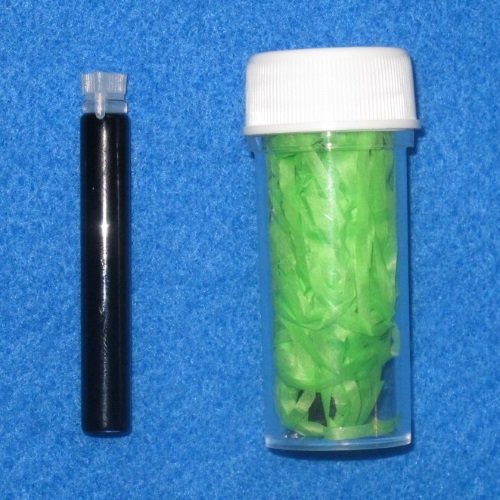- Home
- Questions?
- Ferrofluid
Ferrofluid
What are ferrofluid tweeters?
Many speakers produced from 1990 until today have (metal)dome tweeters damped with "ferrofluid." The concept is that the viscous fluid containing microscopic metal parts, magnetically held in the tweeter voice coil gap, damps resonances as well as cools the voice coil – thus improving sound quality and prevent overheating (and breaking down) of the voice coil.
What is the problem with ferrofluid over time?
Ten to twenty years after production, many of those tweeters will sound dull, have lost sensitivity, or have quit working altogether. This happens because the oil in the ferrofluid has evaporated, leaving a muck or solid in its place preventing the voice coil from moving freely or even blocking it. Some people throw away their speakers at this point and buy new ones. Not a good idea!
Is there anything I can do? My tweeters used to sound great!
Yes, with a bit of effort, your tweeters can be restored to "like new" performance. We will show you how to do this ‘trick’.
First of all, you must take the tweeter from the cabinets. The procedure varies. Please check your manual if unsure how to do it, or look for a manual on the internet, especially with B&W tweeters.
After removing the tweeter from the cabinet mark which wire goes to the + terminal of the tweeter – you might also want to mark the pole on the tweeter itself. Usually the blue or red wires are + or positive and green ones are - or negative – but colors vary. It’s very important to connect the tweeter the same way it was connected before, so make sure you’ve got it all marked. Taking a few pictures might help you afterwards.
Once marked for the positive wire, you have to remove the faceplate of the tweeter – releasing the diaphragm. The dome and voice coil are very so delicate so be careful. To touch the dome is usually to dent it.
Once you’ve released the diaphragm with the voice coil, you can clean it. Use some alcohol on a cotton tip to clean the voice coil. Do this very gently – so you will not damage the coil or the dome. There’s no need to touch the coil or the dome with your hands. Hold the diaphragm by its faceplate.
Now the magnetic gap where the coil resides must also be mucked out – put the diaphragm aside and start your work on the magnet now. There's just no easy clean way to do this. There’s some methods:
One: Drip some alcohol into the gap. While holding a paper towel over the magnet, use a can of compressed air to blow the alcohol and old ferrofluid out of the gap. Repeat until clear alcohol comes out.
Two: Get a plastic card (like a bank card – other strong material’s fine but don’t use paper/carton!) and put some tape around it with the tacky side on the outside. Now put it in the gap, moving it around. Take it out (to the tape old ferrofluid is stuck), replace the tape and repeat. A drop of alcohol can weaken the old ferrofluid and make it easier to remove. Use a plastic tape, no paper tape, so there’s no risk of having tape left in the voice coil gap!
Two: Get a plastic card (like a bank card – other strong material’s fine but don’t use paper/carton!) and put some tape around it with the tacky side on the outside. Now put it in the gap, moving it around. Take it out (to the tape old ferrofluid is stuck), replace the tape and repeat. A drop of alcohol can weaken the old ferrofluid and make it easier to remove. Use a plastic tape, no paper tape, so there’s no risk of having tape left in the voice coil gap!
Once clean, add a SMALL amount of new ferrofluid (for a 1 inch coil 100 ul [1/10 ml] or 2-3 drops is enough). Then place the diaphragm back onto the magnet – placing the voice coil in the gap. The diaphragm is usually self-centering – the magnet has some pins fitting in holes in the diaphragm assembly centering the voice coil. Now attach the diaphragm like it was originally attached – usually by tightening some screws.
Once done, re-connect the wires of the tweeter and screw the tweeter back onto the cabinet. Now you've got some "like new" tweeters that again function as they were intended. If you want you can also take a look at this report with loads of pictures.
My tweeters do not have ferrofluid, will they profit from ferrofluid?
Yes, applying ferrofluid will increase the power handling of your tweeters as well as improve the sound quality, as long as you apply the correct amount of ferrofluid and the correct quality.
How much ferrofluid should I apply?
If you put ferrofluid in the gap, fill it up to ½ to ¾. For a ‘standard’ 1 inch voice coil that’ll be 2-3 drops only. Don’t fill the gap entirely because the voice coil has to go in there as well!
Your ferrofluid is pretty expensive, I've seen cheaper fluids around. Is yours special?
Ferrofluid comes in different kinds, ours is designed to be used with tweeters. Ferrofluid is also used in machines, but most ferrofluid you will find on the web is for educational purposes - to show the students how magnetism works during science classes. The problem is, to show how magnetism works to the human eye, the metal parts in the fluid need to be pretty large. Ferrofluid for tweeters contains microscopic small metal parts that have been shaped too - this makes the ferrofluid more expensive. Ferrofluid for educational use might damage the laquer of your voice coil resulting in a tweeter that's broken beyond (easy) repair. If you buy ferrofluid, make sure it's suitable for use with a tweeter.
Our ferrofluid.
This is a ferrofluid we offer. It's on offer in our shop.
© Good Hifi VOF, 21-05-2022


 Nederlands
Nederlands
 Deutsch
Deutsch
